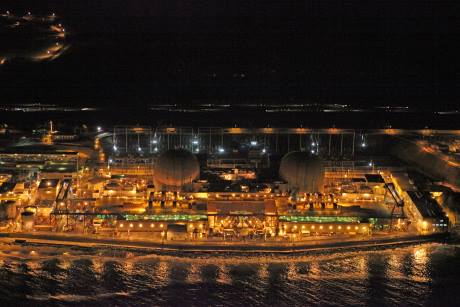As the final fuel is removed from the San Onofre nuclear power plant, California has seen a marked increase in wholesale power prices as a result of the premature closure of the two-unit power station.
 |
| End of the day for SONGS (Image: SCE) |
Southern California Edison (SCE) has completed the removal of fuel from unit 2, the final regulatory step before the unit's operating licence can be officially retired. The defuelling operation was completed on 18 July, with the unit's 217 fuel assemblies placed in storage in the plant's used fuel pool where they will be stored and cooled until they are ready for transfer to dry cask storage.
SCE has notified the US Nuclear Regulatory Commission (NRC) that the defuelling has been completed. Once the regulator certifies the defuelling, the plant's nuclear operating licence will be replaced with a "possession" licence. The company submitted a similar notification for unit 3 at the end of June.
SCE announced in early June that it would retire the two San Onofre Generating Station (SONGS) units in the face of a lengthy and uncertain regulatory review procedure following problems with replacement steam generators discovered in January 2012. The replacement generators should have enabled the units to remain in operation until 2022, but were found to be suffering from excessive wear after only a year in service. SCE is now attempting to claim damages from Mistubishi, the supplier of the defective steam generators.
The company had proposed restarting unit 2, in which the steam generator issues were less severe, at reduced power. This would have provided it with an income while waiting for permission to restart unit 3. However, when the NRC failed to reach a conclusion on the unit 2 restart after over eight months of deliberation the company decided that it could not afford to wait any longer for the protracted regulatory process to run its course.
With both SONGS units off line since January 2012, California's wholesale electricity prices have suffered. Over the first half of 2013, the US Energy Information Administration (EIA) has reported a 59% increase in wholesale power prices in the state, which it ascribes largely to the extended outages at the two units. The situation has also caused a "large and unusual" separation in power prices between the northern and southern Californian electricity grids, which have historically tracked each other closely. Since April 2012, wholesale power prices in the southern part of the state have on average tracked some 12% higher than those in northern California as the "relatively inexpensive" nuclear generation produced by SONGS had to be replaced with power from other, more costly, sources.
Researched and written
by World Nuclear News




_77790.png)
_59102.jpg)

_49833.jpg)
_96167_68292.jpg)


